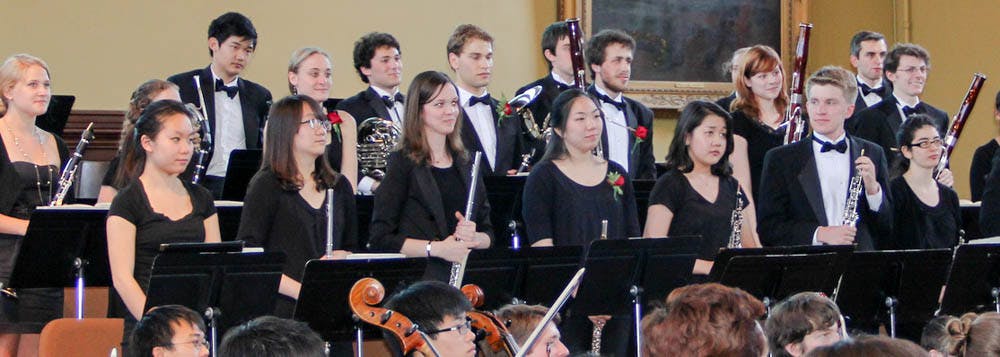Despite a recent and abrupt change in leadership, the Brown University Orchestra sounded cohesive and melodic while rehearsing in Sayles Hall Monday evening for their upcoming concert. Entitled “The Russian Connection,” the concert will feature three pieces reflecting both stable and volatile eras in Russian history.
When creating a concert repertoire, Daniel Harp, teaching associate in music and interim conductor, considers the history behind each piece and develops a theme for the evening. With his emphasis on historical setting, Harp said he hopes his musicians not only learn their music but “live with it and make it their quest to understand its tone.”
With three pieces by composers Pyotr Tchaikovsky, Modest Mussorgsky and Dmitri Shostakovich — composed in vastly different time periods yet connected through a shared Russian history — the program is an ambitious undertaking. Each piece embodies the epoch in which it was written. Tchaikovsky and Mussorgsky, as Romantic period contemporaries, wrote during imperialist Russia, a relatively stable era. Tchaikovsky’s “Romeo and Juliet,” composed in 1869, is based on William Shakespeare’s play. Mussorgsky’s “The Khovansky Affair,” an opera, was written in the 1870s about political upheaval in 1682. The most contemporary work in the trio, Shostakovich’s Symphony No. 5 in D minor, was composed in 1937 in Soviet Russia during the height of Josef Stalin’s purges — and the music reflects it.
“The first two pieces are sweet and romantic, but Shostakovich’s symphony is dark and heavy, almost like you’re bearing this intense burden as you listen to it. But that’s the orchestra’s favorite style of music to play,” said Irene Tang ’19, concertmaster.
These pieces, while telling a musical history of Russia, have greater implications in the context of U.S. politics, Harp said. “As I listen to Shostakovich’s music, I hear it as a warning about political upheaval and the suppression of ideas that were pervasive in Soviet Russia,” he said. “It’s a warning about controlling the press, controlling the arts; it is really a cautionary tale of the kind of totalitarian ideology that can infiltrate a democracy.”
Since their last performance in October, the orchestra has seen a lot change — and an upheaval of their own. When Harp stepped in to replace former conductor Brandon Keith Brown after his sudden departure from his position, he not only had to quickly assemble the repertoire for the upcoming November concert, but also had to reunify the fractured orchestra. The orchestra recruited new students and urged musicians who left during Keith Brown’s brief tenure to return, according to Orchestra President Katie Rademacher ’19.
As the University searches for a permanent conductor, Rademacher is optimistic about the future of the orchestra. “We’ve all moved on,” she stated. “We’ve grown a lot closer, moods have been really high and we are (playing) really fun and exciting music. There will not be a dull moment in this concert.”
The concert will be held Thursday, Nov. 30 and again Friday, Dec. 1 at 8 p.m. in Sayles Hall.





